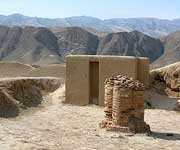The Parthian Fortresses of Nisa consist of two tells of Old and New Nisa, indicating the site of one of the earliest and most important cities of the Parthian Empire, a major power from the mid-3rd century BC to the 3rd century AD. They conserve the unexcavated remains of an ancient civilization which skilfully combined its own traditional cultural elements with those of the Hellenistic and Roman west. Archaeological excavations in two parts of the site have revealed richly decorated architecture, illustrative of domestic, state and religious functions. Situated at the crossroads of important commercial and strategic axes, this powerful empire formed a barrier to Roman expansion while serving as an important communication and trading centre between east and west, north and south.

Continent: Asia
Country: Turkmenistan
Category: Cultural
Criterion: (II)(III)
Date of Inscription: 2007
Traces of human activity
Traces of human activity was dating back to the 4th-2nd millennia BCE show that long before the beginning of the Parthian Empire the area of Nisa was already colonized by sedentary populations. It is believed that there was a large settlement there as early as the 1st millennium BCE. Nisa underwent a major development in the mid-3rd century BCE, when impressive buildings were erected by the Parthians, who decided to build a royal residence, probably the first of the Parthian dynasty.The name of the site, Mithradatkert, and an indication of the date of its foundation are known from an inscription written on one of the 2,700 administrative ceramics (ostraka) found at Nisa. Mithradatkert means 'the fortress of Mithidrat,' referring to King Mithradat I (174-138 BCE).
 |
| Parthian Fortresses of Nisa |










0 comments:
Post a Comment